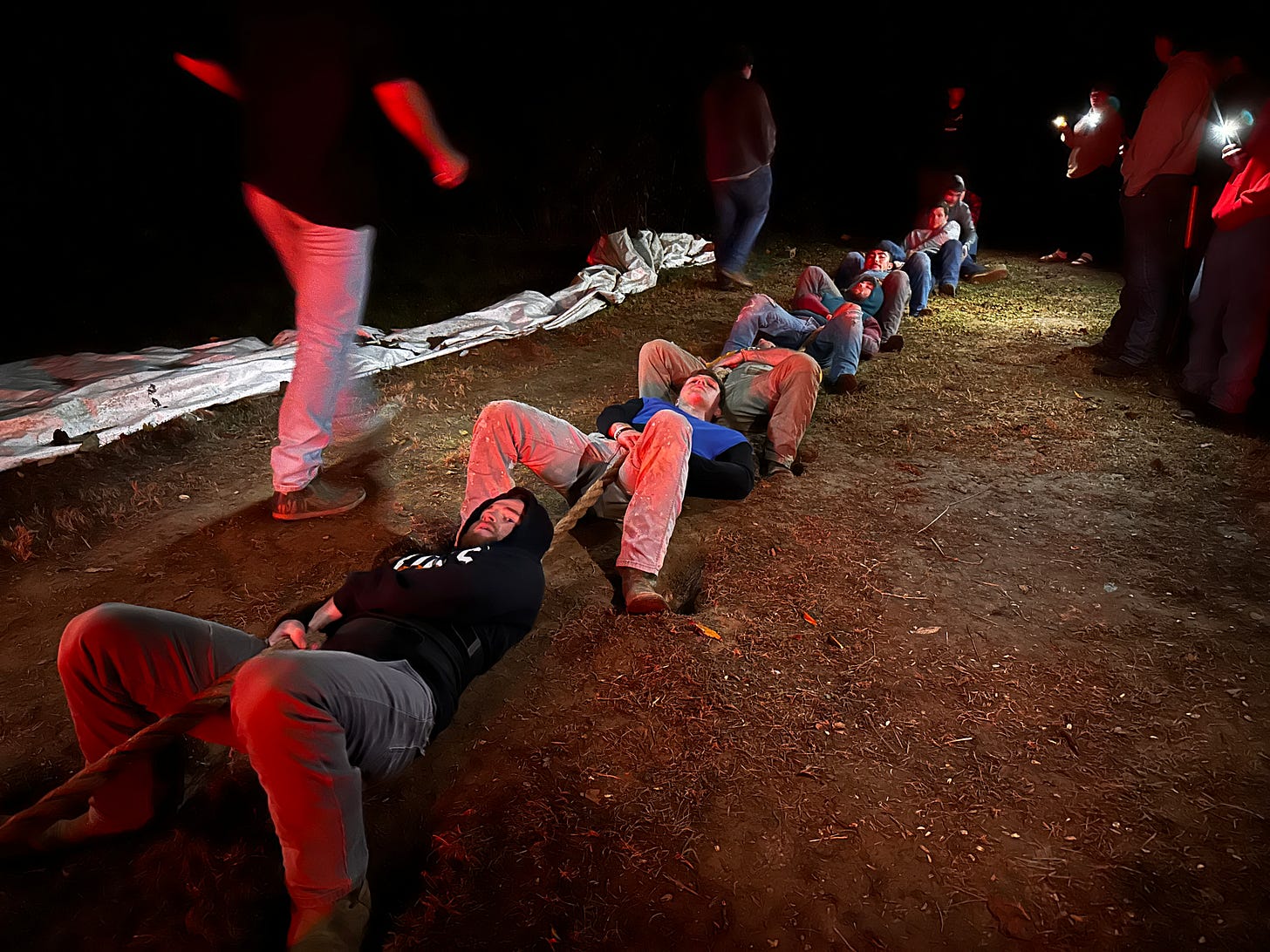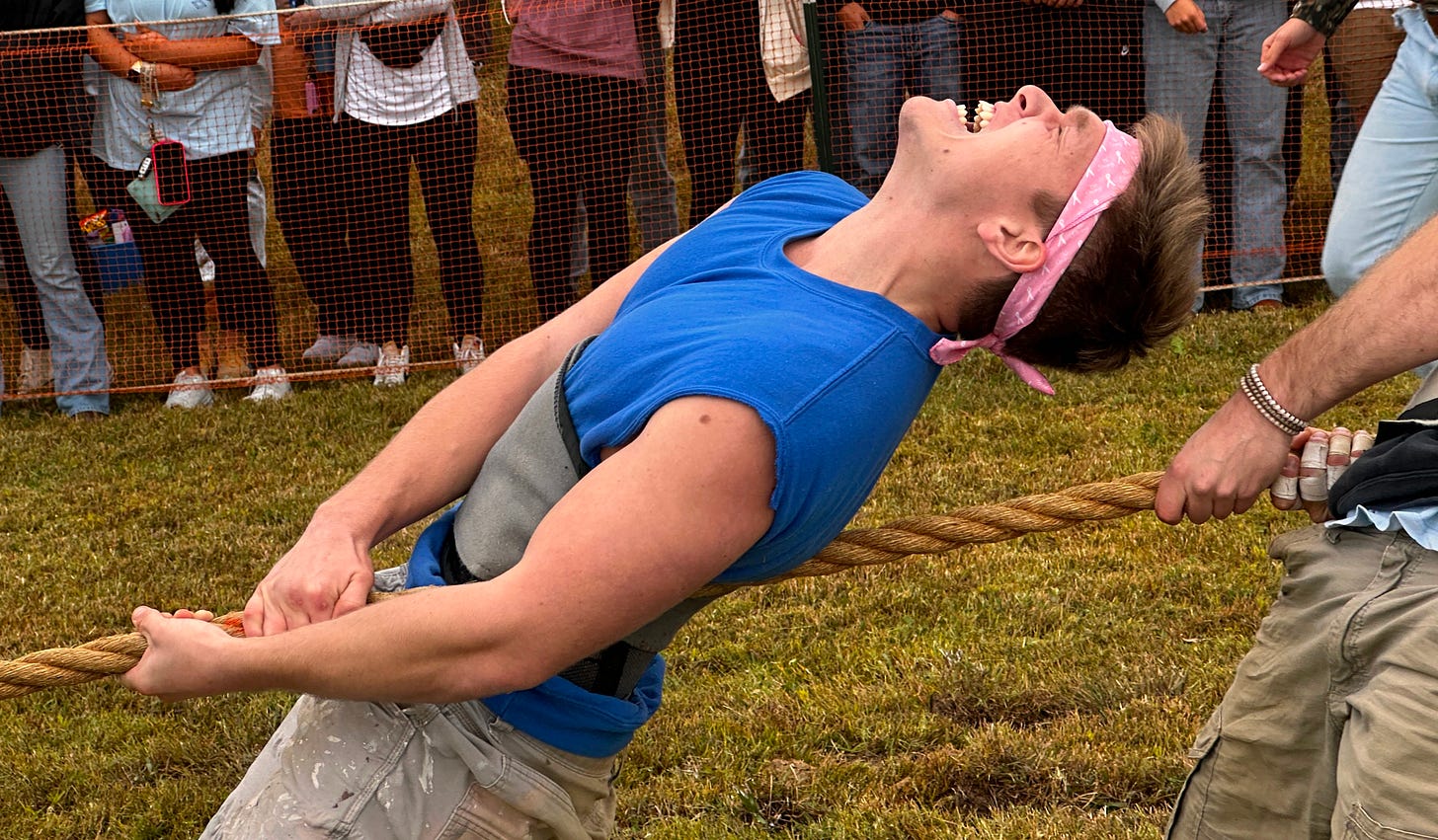Time & Toughness
What it Takes for Teams to be Tried and True
It's 8 p.m., and I'm standing in the middle of farmland in far northwest Tennessee on a mild October evening. The brothers of Kappa Alpha fraternity are getting set for an evening Rope Pull practice. This is dark sky country, so the team uses their truck headlights to illuminate the practice area.
Players are dressed to get in the dirt and grind out a one-hour practice. There's no joking around or small talk tonight, just serious work to be done. The men begin prepping the area as soon as they arrive, ensuring the holes they've dug are still in proper shape. The team, led by head coach Jake Sorrells, huddles quickly to review the plan for the evening. They'll have two practice pulls with a 15-minute break between each pull to rest and discuss their performance. Their formidable opponent is a Ford F-250 owned by one of the team's coaches. The men will try their best to budge the truck from its parked position on the field.
Jake says the team spends three to four nights each week practicing for the Rope Pull tournament. All of the game's eligible participants are full-time students, and most of them have part-time jobs after school. Between work, Rope Pull practice, social activities, and schedule full of classwork, the men don't have much time for anything else in the months leading up to the competition.
Regulation play on a Rope Pull match is 20 minutes, but most contests last less than eight minutes. For contestants, every single second on the rope is excruciating. Jake told me that the game is mostly won by endurance - a blend of physical and mental strength that's required for teams to be successful.
“We’re going to be holding (the rope) for a long time tomorrow. Get used to it.” - Coach Jake Sorrells
As the old saying goes, "When the going gets tough, the tough get going." I found that expressions like these are not only full of wisdom but also have become motivational in my own leadership and teamwork journey.
One step, One punch, One Round
Jon Acuff wrote a book titled Soundtracks in which he describes how we give power to particular phrases that play over and over again in our heads. These sayings are sentences that we've picked up from different places and people in our lives, such as teachers, friends, songs, and literature.
I've struggled with being overweight for my entire life. As I approached my 40th birthday, I was determined to improve my health and drop a pant size or two. I adopted the goal…
"Fit by 40.”
That phrase played on repeat in my brain as a motivating mantra that helped me tap into more will power and determination.
Another soundtrack that fueled my fitness goal comes from the film Creed, a spin-off sequel of Sylvester Stalone's Rocky franchise. In this movie, the retired boxer Rocky Balboa trains a new contender, Adonis Creed, who is a young, aspiring boxer and the son of Rocky's late friend and former boxing opponent Apollo Creed. During one of the training sequences, Rocky motivates Adonis with the line…
"One step at a time, one punch at a time, one round at a time."
That's how Rocky believes that boxing matches are won - a sustainable pace and a steady performance can provide a path to victory. This is the formula that Rocky used to become the world heavy-weight champion. He wasn't the strongest, the biggest, or the most talented boxer. As he describes it, the key to winning a boxing match and achieving success in general "ain't about how hard you hit. It's about how hard you can get hit and keep moving forward. How much you can take and keep moving forward. That's how winning is done."
The phrase "one step at a time, one punch at a time, one round at a time" was a regular motivation in my fitness journey. I set my sights on completing a 10k race, which seemed like an incredible stretch goal for me. I never enjoyed running, but I believed that this was the type of workout that I could commit to with great regularity and without needing to know much about technique. I mean, isn't running just moving your feet faster for an extended period of time? Technically, yes, but you won't last long in distance running if you don't understand how to pace yourself, how to breathe from your nose, and how to use correct form in your stride.
Experienced runners know that the proper mechanics of running are important to reduce injury and maintain consistency in performance. In my experience though, long-distance running is 20 percent physical and 80 percent mental. On any given practice run or race, my mind is likely to call it quits 10 times faster than my body will. I continually push myself over mental walls during a run so that I can reach the finish line.
The Whole is More Than the Sum of Its Parts
While long-distance running is an individual sport, the lessons I've learned on time and toughness also apply to successful teams. Each player is capable of contributing a strong performance, but that power is multiplied when strong players come together to form a team.
According to Gestalt theory in psychology, "the whole is more than just the sum of its parts." Experts in organizational behavior say this idea also applies to teamwork.
Simply assembling strong players doesn't automatically amount to guaranteed success on teams. It’s the relationship between those parts that creates something greater, often referred to as synergy. When people work together, they can achieve much more than one or two individuals could on their own.
Time and toughness are interlinked elements of winning teams because they fuel one another. In my experience, you can't achieve success without a willingness to put in hard work, which takes time. And, you've got to be consistent in the level of effort and the length of commitment to reach your team's goals. Going the full distance requires sacrifice of the most valuable resource on the planet - your time. Time is non-renewable. You can quickly assess what you value most by where you spend your time and who you spend it with.
In fact, the very rope used for Rope Pull can be used as a physical metaphor to show the interconnectedness of time and toughness. The rope gains its toughness because the individual threads are tightly woven. The combination of the threads makes the threads stronger than they would be on their own. The combination of threads creates the physical integrity needed for the rope to sustain the duration of each match, and that same rope is used year after year. Strong ropes are made from the proper combination of threads, and a strong rope - like a strong team - can withstand the test of time and extreme tension.
Up Next: Training and Tools
Rope Pull victories are hard won, and you don't get to the championship pull without experienced coaches who ensure you have the equipment you need to be successful. The next entry in this series will focus on the impact that training and tools have on thriving teams.
Key Takeaways
A sustainable pace and a steady performance can provide a path to victory.
Each player is capable of contributing a strong performance, but that power is multiplied when strong players come together to form a team.
Time is non-renewable. You can quickly assess what you value most by where you spend your time and who you spend it with.
Strong ropes - like strong teams - can withstand the test of time and extreme tension.




